“We do anticipate having to deploy nuclear systems on the lunar surface."
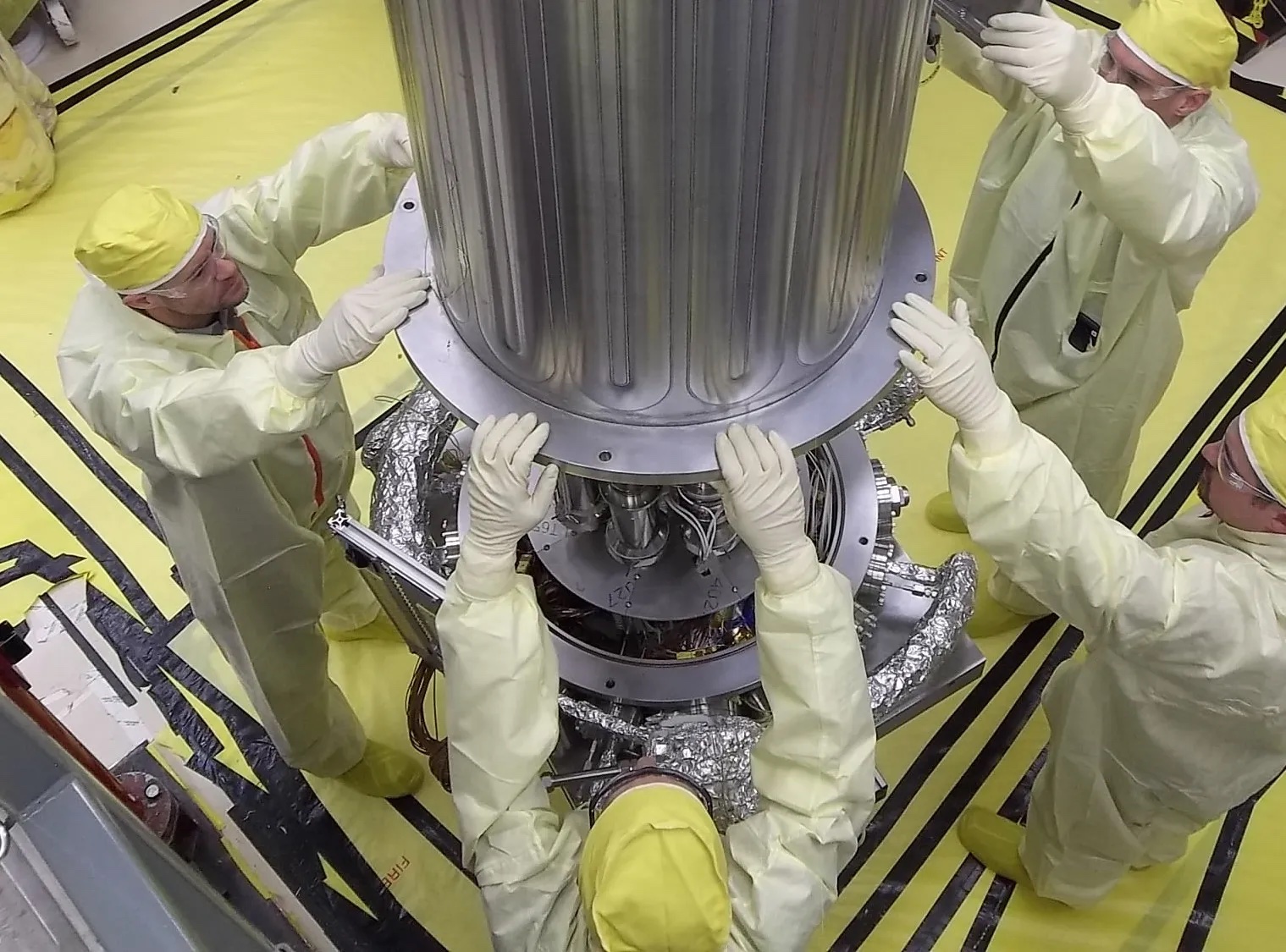
Engineers from NASA and the National Nuclear Safety Administration lower the wall of a vacuum chamber
around the KRUSTY experiment, the Kilowatt Reactor Using Stirling Technology.
Los Alamos National Laboratory
In February, NASA celebrated the arrival of the first US-made lander on the Moon in more than 50 years, an achievement that helps pave the way for the return of American astronauts to the lunar surface later this decade. But the clock was ticking for Intuitive Machines' Odysseus spacecraft after touching down on February 22 near the Moon's south pole.
Each day and night on the Moon lasts two weeks. When the Sun sets, a solar-powered lunar lander like Odysseus is starved of energy. Temperatures during the lunar night plummet, bottoming out at around minus 280° Fahrenheit (minus 173° Celsius).
Over the course of two weeks, these cold temperatures can damage sensitive spacecraft equipment, killing a lander even if it could start generating power again at lunar sunrise. Surviving the night requires heat and electricity, and NASA officials say nuclear power is one of the most attractive solutions to this problem.
Freezing to death
“We do anticipate having to deploy nuclear systems on the lunar surface," said Jay Jenkins, program executive for NASA's Commercial Lunar Payload Services (CLPS) program.
"Honestly, it’s not unrealistic that we’ll want to do be able to do this within five years or less. We are starting to buy payloads that are meant for investigations that go beyond one lunar day," Jenkins said during a Nuclear Regulatory Commission conference earlier this month.
The commercial Odysseus lander was part of CLPS. Intuitive Machines had a $118 million contract with NASA to deliver science and tech demo payloads to the lunar surface.
As expected, Intuitive Machines declared the end of the Odysseus mission last month when ground teams confirmed that the lander did not make it through the night. Just in case it woke up, engineers tried listening for a signal from the spacecraft, nicknamed Odie, but didn't hear back.
"This confirms that Odie has permanently faded after cementing its legacy into history as the first commercial lunar lander to land on the Moon," Intuitive Machines posted on X.
“Because of the extreme temperatures through the lunar night, typically, you don’t come back to life," said Peter McGrath, chief operating officer of Intuitive Machines, before the launch of Odysseus last month. "The batteries don’t survive, the boards crack on the computers and the avionics boxes, and even though you may be able to collect power through the solar arrays, you really don’t have anything that functions, so we’ve been looking at how to keep landers alive.”
India's Chandrayaan 3 lander also didn't make it past its first lunar day after it arrived on the Moon last August. There are exceptions, though. Japan's SLIM lander touched down on the Moon in January and is still alive, even though Japanese engineers expected it would succumb to cold temperatures during its first lunar night. Japan's space agency said some temperature sensors and unused battery cells on SLIM are starting to malfunction, but the "majority of functions" have survived so far.
The first phase of America's return to the Moon, initially consisting of robotic commercial missions and then larger human-rated landers, will have the same limitations as Odysseus. The next series of commercial landers set to launch to the Moon under contract with NASA are all designed to operate for one lunar day. The first human landing on the Moon under NASA's Artemis program, Artemis III, will spend up to six days on the lunar surface. The astronauts won't stay the night.
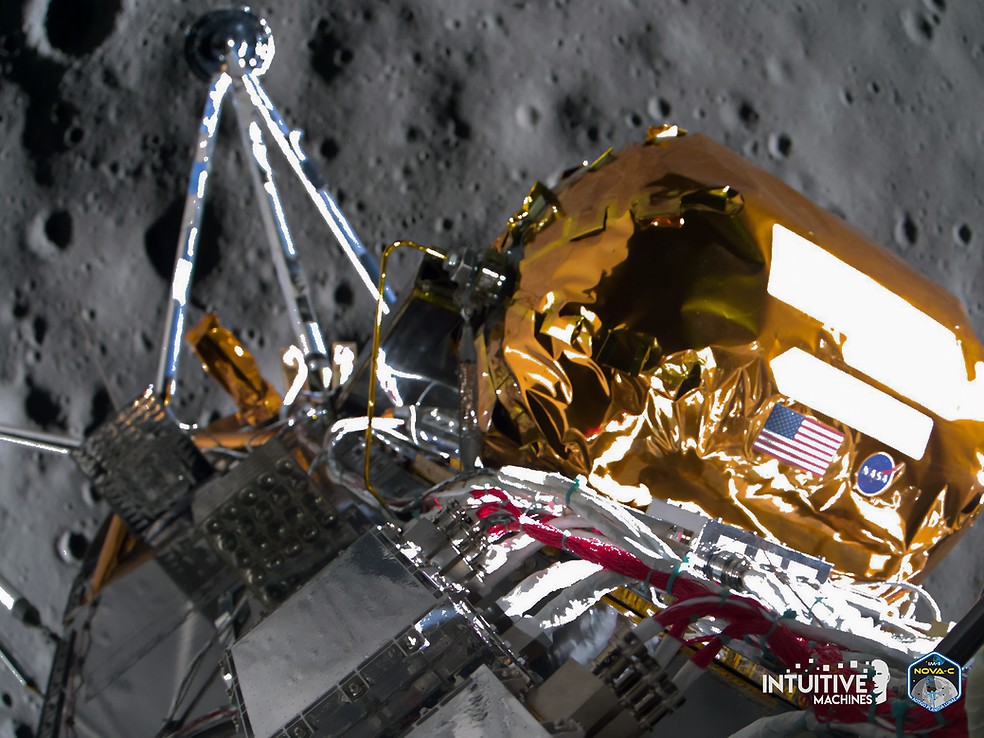
Intuitive Machines' Odysseus lander is shown shortly before touching down on the Moon.
Intuitive Machines
NASA's long-term goal is to build a sustainable presence on the lunar surface. Mission lifetimes of one or two weeks won't cut it for a Moon base.
"Right now, all the CLPS deliveries basically land at lunar morning and they end at lunar evening," Jenkins said. "That’s very very limiting, especially for experiments that we would like to go for a very long time, for months or years, in order to monitor geophysical properties, or in order to monitor various other aspects of the Moon."
NASA also wants to venture into permanently shadowed craters at the Moon's south pole. The bottoms of these craters haven't seen sunlight for billions of years, and observations from orbit suggest these cold traps harbor water ice, a valuable resource for future lunar explorers.
“So survive-the-night capability, or STN, is very highly desirable," Jenkins said.
Around-the-clock operations
Until now, nearly all of NASA's funding for the Artemis program has gone to developing rockets, spacecraft, and landers. This week, the space agency announced contractors to perform feasibility studies for a lunar rover to carry astronauts from point to point on the lunar surface.
Once these key pieces of the architecture are in place, they will need a new kind of power source, and the nuclear option is attractive. Reactors could continuously run a Moon base or a science outpost and make permanently dark craters accessible for astronauts or robots to reach water ice that could be converted into rocket propellant or air.
“I think the only way you’re going to have a sustainable presence on the surface of the moon is using nuclear power," said McGrath, an executive at Intuitive Machines, which is investing in several types of nuclear power systems.
NASA and the US military are providing funding for these efforts, beginning with the test of a nuclear thermal propulsion in orbit in 2027. This demonstration will involve a small nuclear reactor, similar to one that could be used to generate power on the Moon. The reactor will rapidly warm up liquid hydrogen propellant; the gas expands and is passed out a nozzle, creating thrust vastly more efficiently than a conventional rocket.
In a separate program, NASA awarded relatively low-cost preliminary design contracts in 2022 for three industrial teams to work on concepts for 40-kilowatt-class, six-metric-ton nuclear fission reactors to operate on the lunar surface. Some of the same companies working on the nuclear rocket program, like Lockheed Martin and BWXT, are working with NASA to apply the reactor technology to the Moon.
“We are making investments in a modular reactor for a lunar surface demonstration," said Prasun Desai, deputy associate administrator for NASA's space technology directorate.
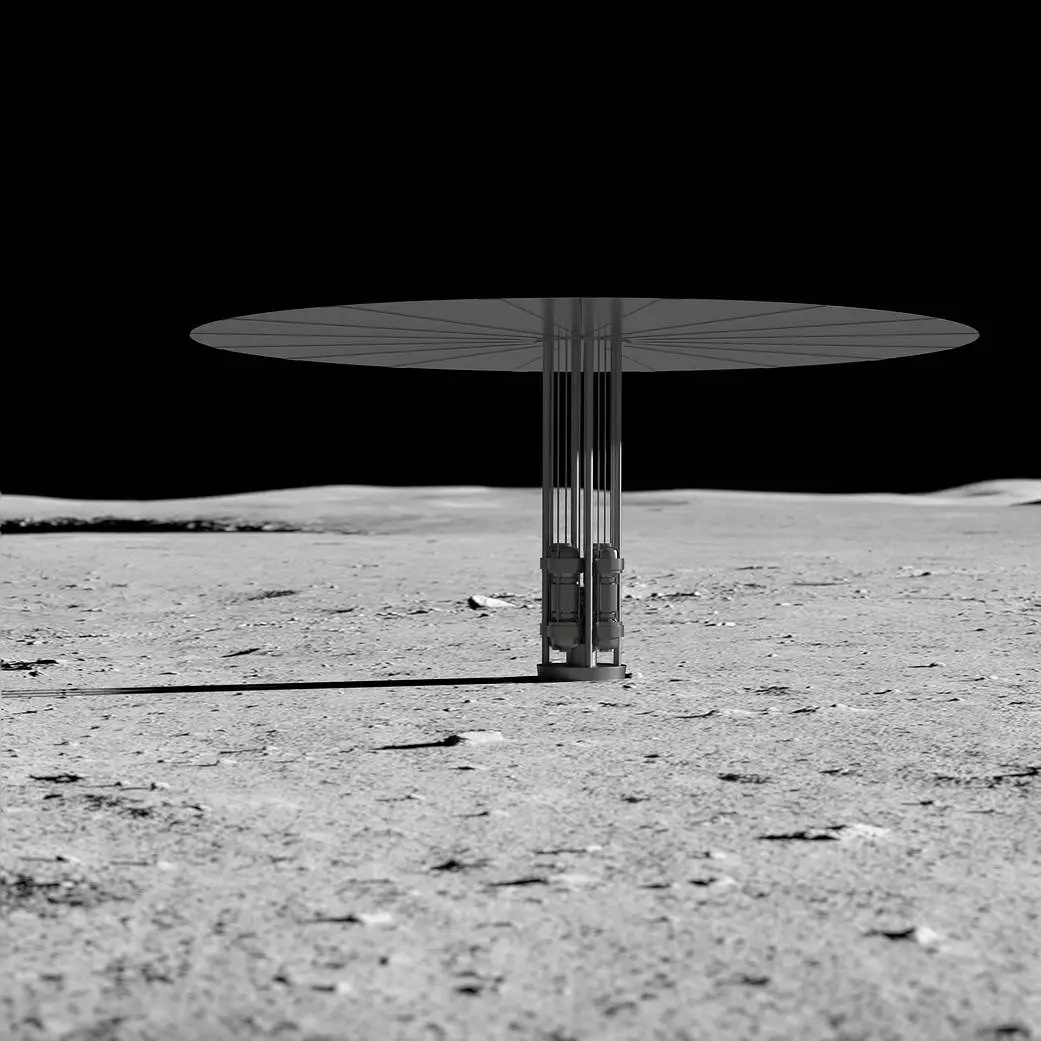
Artist's illustration of a nuclear reactor on the Moon.
NASA
Buoyed by its successful Moon landing, Houston-based Intuitive Machines is also part of these NASA nuclear design contracts. It is partnering with X-energy, a nuclear energy startup, in a joint venture called IX. X-energy and Intuitive Machines were founded by Kam Ghaffarian, a billionaire entrepreneur who also founded Axiom Space.
“We started as a lander company, but we're doing a lot of things about how do we prolong missions and keep things alive," McGrath said at a recent discussion hosted by the Beyond Earth Institute. "There's a lot of value in nuclear (power) on spacecraft because you can actually move without worrying about power draw from the Sun and do missions as well as transit through space. So it gives you a lot more operational capability.”
Westinghouse leads the third team that won NASA funding in 2022 to work on a Moon-based nuclear reactor design. These three industrial consortiums are completing work under Phase 1 of the NASA reactor program. The agency plans to open a competition for Phase 2 next year, with a target date of delivering a nuclear reactor to the Moon in the early 2030s. Budget constraints delayed this delivery date by a few years from NASA's previous plan.
"On the Moon, the reactor will complete a one-year demonstration followed by nine operational years," NASA said in a statement. "If all goes well, the reactor design may be updated for potential use on Mars."
So far, NASA officials are pleased with the lunar design concepts proposed by the nuclear industry. "They came back with some very innovative approaches to solving the problem," said Anthony Calomino, manager of NASA's space nuclear technology portfolio.
A 40-kilowatt reactor could produce electrical power for 33 average US households, according to NASA. This is enough to run lunar habitats, rovers, backup power grids, or science experiments on the Moon.
Surviving the night
Nuclear reactors have flown in space before. The Soviet Union launched around 40 military satellites powered by fission nuclear reactors, and some of these are still in Earth orbit today. The United States sent one experimental nuclear reactor into orbit in 1965.
Numerous NASA interplanetary probes have relied on a different type of nuclear power source, called a Radioisotope Thermal Generator (RTG), which converts heat from decaying plutonium into electricity. These missions include the Voyagers, the Cassini spacecraft to Saturn, and NASA's Curiosity and Perseverance Mars rovers.
It doesn't generate electricity, but there is another simpler, near-term solution that can allow robotic landers and rovers to safely hibernate during the cold lunar night. These devices, called Radioisotope Heater Units (RHUs), are like tiny RTGs, with a pellet of plutonium about the size of a pencil eraser outputting about 1 watt of heat, enough to protect sensitive spacecraft components from thermal damage.
China's Chang'e 3 and Chang'e 4 robotic lunar landers used RHUs to survive the long lunar night. McGrath said Intuitive Machines is investigating this capability for its future landers. But these heaters won't enable around-the-clock operations.
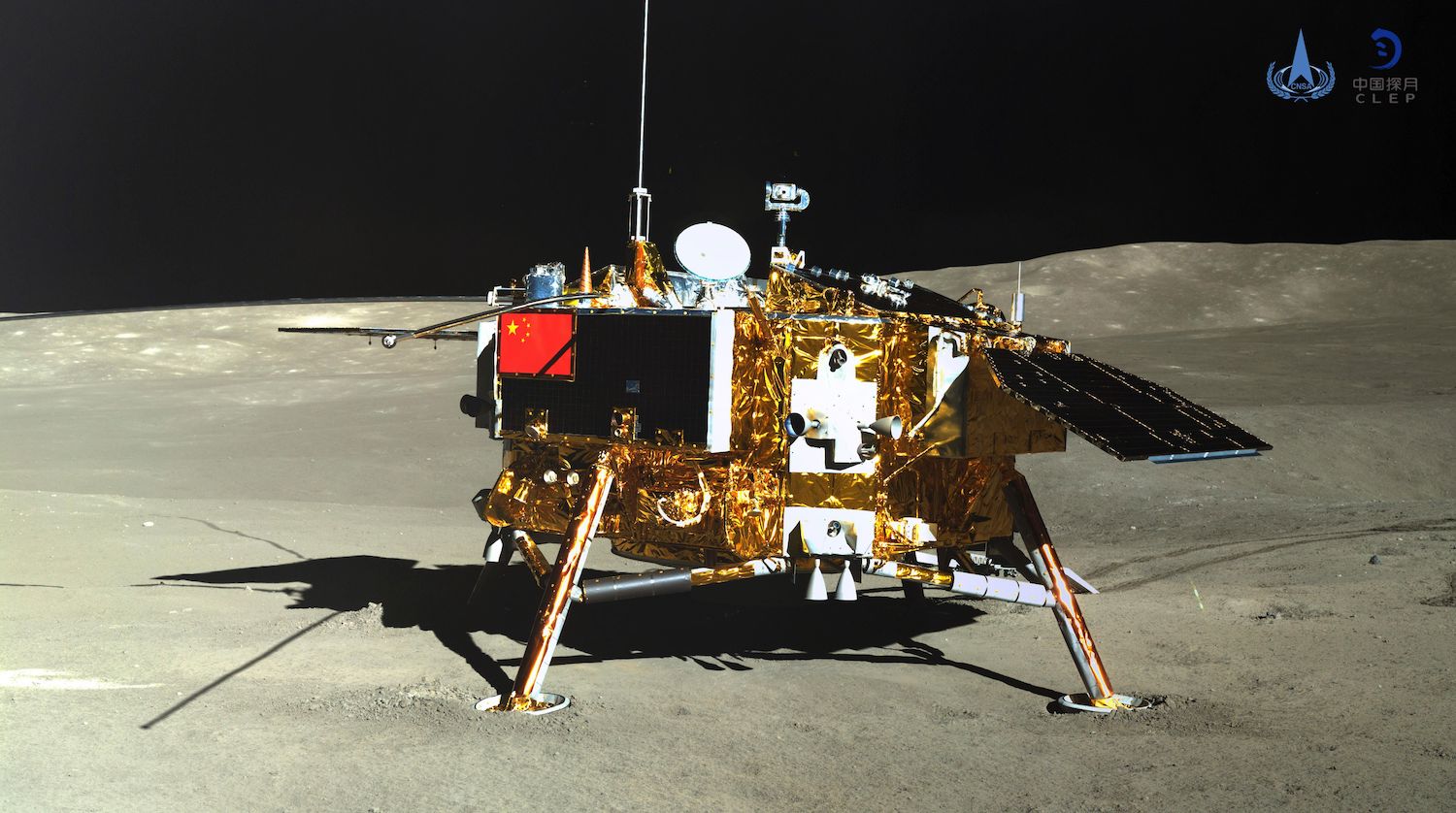
China's Chang'e 4 lander on the far side of the Moon in January 2019.
China National Space Administration/AFP via Getty Images
"In terms of a near-term operational need, we need to see that fission power system also on the surface of the Moon," said Scott Pace, a space policy expert who served as executive secretary of the National Space Council in the Trump administration.
RTGs and RHUs are produced by the Department of Energy, while the technology NASA eyes for the Moon comes from commercial suppliers. In 2018, NASA successfully tested a 10-kilowatt fission reactor in a vacuum chamber simulating the environment of space. But the commercial space nuclear power industry is still a fledgling industry.
“We have been behind the 8-ball," said Mike Beavin, a former space policy adviser at NASA and now an industry consultant at the Beyond Earth Institute's panel discussion last month. "In my personal opinion, I think we’re probably about a decade back from where we should be in the development of space nuclear systems. Where we were with commercial space 20 years ago is kind of like where we are now with space nuclear."
Winning hearts and minds
Historically, launching nuclear material into space hasn't been free from controversy. Anti-nuclear activists protested at Cape Canaveral, Florida, before the launches of NASA's Galileo and Cassini spacecraft in 1989 and 1997. These robotic spacecraft safely launched and orbited Jupiter and Saturn, relying on plutonium power generators. The launches of NASA's plutonium-powered Mars rovers in 2011 and 2020 didn't have the same level of protest.
“The 1997 Cassini protests I think were really a high point of opposition," said Alex Gilbert, director of space and planetary regulation at Zeno Power, which won a $15 million funding award from NASA last year to develop a radioisotope power system utilizing americium instead of plutonium. Zeno is also partnering with Intuitive Machines.
Jeffrey King, a nuclear engineering professor at Colorado School of Mines, isn't so sure this new age of space-based nuclear power will avoid dissent.
“I do think we need to be prepared and have our messaging on target," he said at a recent symposium hosted by the Universities Space Research Association and the Space Policy Institute. "You can see it if you pay attention, and that opposition is going to come.”

US Air Force security personnel at Cape Canaveral, Florida, formed a line to thwart protesters before the
launch of NASA's Cassini spacecraft in October 1997.
AFP Photo/Roberto Schmidt
A commercial launch of nuclear material into space would also open new challenges in federal regulation. The Nuclear Regulatory Commission (NRC) and the Federal Aviation Administration (FAA) will hold joint responsibility to ensure public safety.
"Whoever the mission owners are who want to do this, they would have to go through multiple steps, potentially, of licensing and safety reviews," said Tina Gosh, a senior reactor systems engineer at the NRC.
Jenkins, from NASA's CLPS commercial lunar lander program, is pushing for clarity on the regulatory requirements for commercial nuclear power systems. NASA's most recent nuclear-powered missions have launched on United Launch Alliance's soon-to-be-retired Atlas V rockets, so the agency is beginning the process to certify other launchers, like SpaceX's Falcon 9, Falcon Heavy, and ULA's Vulcan, for nuclear payloads.
“We’ve got commercial entities that want to comply, but they don’t know what to comply with," Jenkins said. "We all know we want to be able to handle these things safely. We want to be sure that we don’t have a bunch of live nuclear sources around that astronauts are going to have to tiptoe around.”
There are other power options for 24/7 operations on the Moon. Astrobotic, another one of NASA's lunar lander contractors, is working on a concept to robotically reel out up to a kilometer of cable on the Moon's surface. This cable could route electricity from solar arrays into shadowed areas and could be particularly useful near the lunar poles, where mountains at the rims of some craters range high enough to receive near-constant sunlight.
Astrobotic has a different concept called the Nighttime Integrated Thermal and Electricity (NITE) system, which could produce power as a byproduct of exothermic chemical reactions. This non-nuclear generator design requires no radioactive materials and wouldn't need to go through a potentially lengthy, expensive nuclear launch approval process, Astrobotic says.
Ultimately, it's up to commercial companies like Intuitive Machines and Astrobotic to decide how to satisfy NASA's desire for landers that can survive the lunar night, "whether it's a battery solar array arrangement or whether it's a commercial radioisotope arrangement, or even fission," Jenkins said.
"We do anticipate that commercial radioisotopes are going to take a significant role with the CLPS providers in order to provide the survive-the-night capability," Jenkins said. "You can do things with solar arrays and batteries, but the battery mass just becomes enormous when you start trying to operate for two consecutive weeks of night.”
The last time NASA was this serious about nuclear power in space was a generation ago. NASA spent around $400 million on Project Prometheus, which would have developed nuclear reactors to supply electricity to ion engines, before canceling it in 2005 to free up money for the Constellation Moon program. Constellation was later canceled in 2010.
There are geopolitical angles to consider, too.
The head of Russia's space agency, Roscosmos, said this month that Russia and China are "seriously considering a project" to put a nuclear power unit on the Moon in the 2030s. Russia's space program is in decline, but the country is a major player in the global nuclear power sector. In contrast to Russia, China's space program is well-funded, and the Chinese nuclear sector is growing fast.
China has "leapfrogged" the United States in a few areas of space-based nuclear power, McGrath said. China recently demonstrated a Stirling power converter, which could be used on a future space nuclear fission reactor, on the Tiangong space station.
“We’re not pushing hard enough, and we’re not pushing fast enough," Beavin said last month. “I do think we are ahead, but they’re closing the gap, that’s for sure."
This story was updated to reflect NASA's announcement April 3 of lunar rover contractors.
Source




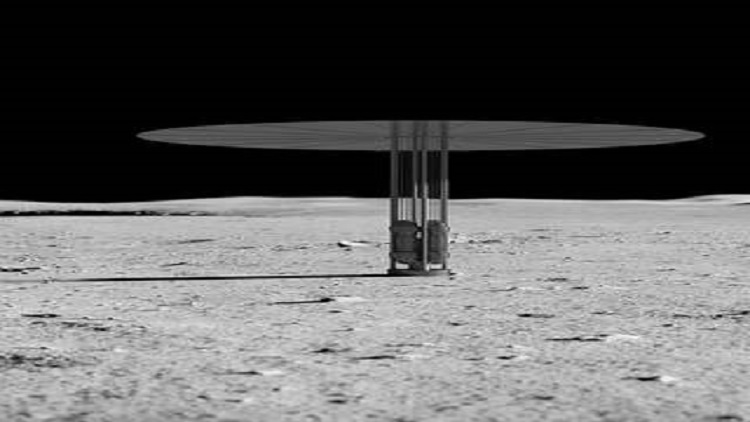
3175x175(CURRENT).thumb.jpg.b05acc060982b36f5891ba728e6d953c.jpg)



Recommended Comments
There are no comments to display.
Join the conversation
You can post now and register later. If you have an account, sign in now to post with your account.
Note: Your post will require moderator approval before it will be visible.